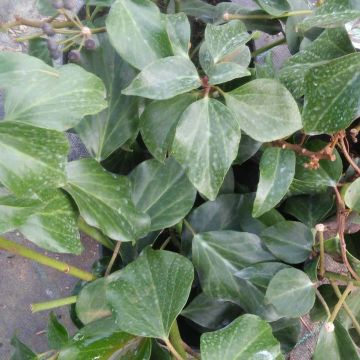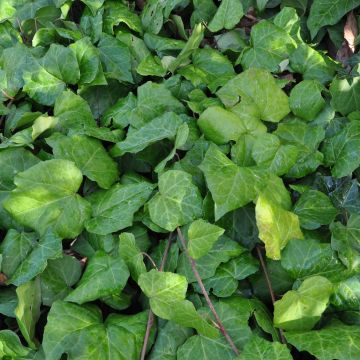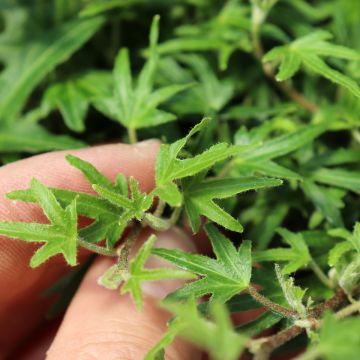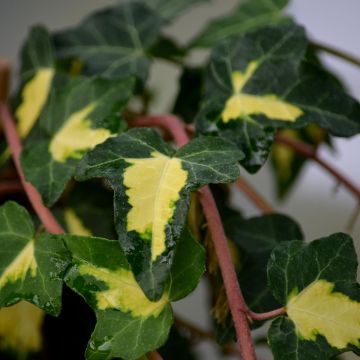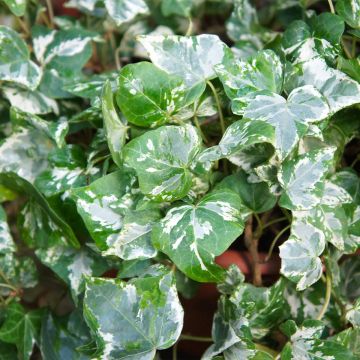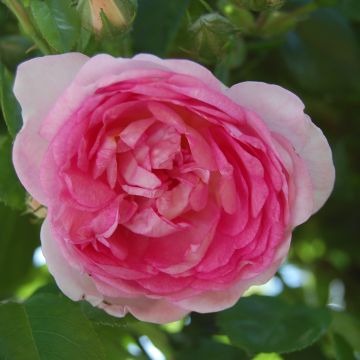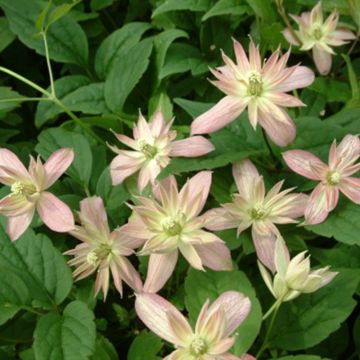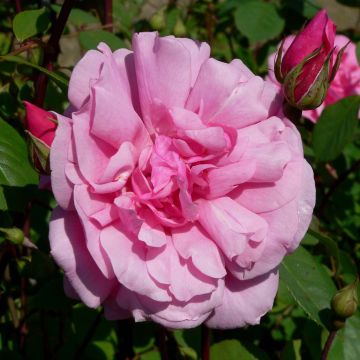

Hedera algeriensis - Lierre d'Algérie
Hedera algeriensis
Hedera algeriensis
Algerian Ivy, Canary Island Ivy
This item cannot be shipped to the selected country
Delivery charge from €5.90
More information
Schedule delivery date,
and select date in basket
This plant carries a 6 months recovery warranty
More information
We guarantee the quality of our plants for a full growing cycle, and will replace at our expense any plant that fails to recover under normal climatic and planting conditions.
From €5.90 for pickup delivery and €6.90 for home delivery
Express home delivery from €8.90.
Does this plant fit my garden?
Set up your Plantfit profile →
Description
This Algerian ivy, in Latin Hedera algeriensis, is a plant more inclined to be creeping rather than climbing, known to gardeners under its pretty variegated variety 'Gloire de Marengo'. Its large leaves, a bright light green in spring, become dark green in summer. This vigorous species forms a remarkable evergreen ground cover in partially shaded or even shady areas. With a little help, by training it, it will also create a beautiful green tapestry on a fence wall. Ideal for dressing a large slope or the base of a hedge, it withstands summer drought once well established. It is the perfect plant to fight against adventive plants and cover the ground evenly.
Hedera algeriensis is a botanical species native to the Tunisian and Algerian coasts, where it grows up to mountainous areas. Its frost resistance is estimated at -15 °C (5°F) at its lowest. Ivies belong to the Araliaceae family, they are cousins of Ginseng and Fatsias. Its growth is fast, allowing it to cover an area of 8 to 10m² in a few years. Its large oval, triangular, leathery leaves, with slightly marked 3 lobes, have a slightly wavy appearance. They measure up to 20cm (8in) long and 12cm (5in) wide. Those carried by the flowering branches are less lobed than those of sterile branches. They have a light and vibrant green colour in spring, darkening with age. Its reddish branches, partially covered with greyish star-shaped hairs, run on the ground or climb when they encounter an obstacle to cling to. This ivy only produces flowers on the erect fertile stems and branches that have reached the sun. The inflorescence, in umbel form, gathers 13 to 15 flowers with prominent yellowish-green stamens, highly melliferous. After pollination by bees, small blackish, fleshy berries form, which are toxic when ingested. They are sought after by some birds that spread the seeds in the garden, often at the base of 'perching trees'.
Everything suits it, and it suits everything! A statement that sounds like a plea for ivy, a modest but greatly useful plant, although usually frowned upon by gardeners. It must be admitted that it tends to infiltrate everywhere, with the complicity of birds who sow it here and there. On the other hand, it quickly enhances all the difficult areas of the garden neglected by other plants, in the sun or even in the shade, in a soil full of roots, dry in summer, limestone, clayey. The luxuriant vegetation of Algerian ivy effectively and perfectly covers the ground, eventually discouraging adventive plants. Like a mulch, it helps maintain soil moisture in summer without harming well-established shrubs and trees. When trained, it has a slightly trailing drapery habit. For example, associate it with periwinkles, Pachysandra terminalis, and climbing clematis 'The President' to create a large original and colourful ground cover on a slope.
Did you know?
The flowering of ivy is an excellent source of food for bees in late summer or autumn. Even though their reputation as destroyers is well established, ivies have protected old dilapidated walls more than they have destroyed them; it is the uprooting of this plant firmly anchored in the crevices that causes the masonry to collapse, while the plant maintains its integrity.
Report an error about the product description
Plant habit
Flowering
Foliage
Botanical data
Hedera
algeriensis
Araliaceae
Algerian Ivy, Canary Island Ivy
North Africa
Other Hedera - Ivy
Planting and care
Algerian Ivy, a plant that is easy to grow, can be planted all year round in ordinary soil that has been well prepared to facilitate its installation and kept moist during the first two years after planting. It is not demanding in terms of soil type, and it is not afraid of limestone, stones, or heavy clay soils if they are properly loosened and drained. It adapts to all exposures, from sun to shade, but prefers partially shaded situations sheltered from cold winds. To promote the emergence of young shoots more quickly, fix the first ones to the ground (layering). Train the long, flexible stems to help them cling to a support (fence or garden shed). Do not hesitate to rejuvenate the base by removing old branches if necessary. Regularly prune to shape or maintain it within a defined space. This plant is not affected by pests or diseases.
Planting period
Intended location
Care
This item has not been reviewed yet - be the first to leave a review about it.
Foolproof climbers
Haven't found what you were looking for?
Hardiness is the lowest winter temperature a plant can endure without suffering serious damage or even dying. However, hardiness is affected by location (a sheltered area, such as a patio), protection (winter cover) and soil type (hardiness is improved by well-drained soil).

Photo Sharing Terms & Conditions
In order to encourage gardeners to interact and share their experiences, Promesse de fleurs offers various media enabling content to be uploaded onto its Site - in particular via the ‘Photo sharing’ module.
The User agrees to refrain from:
- Posting any content that is illegal, prejudicial, insulting, racist, inciteful to hatred, revisionist, contrary to public decency, that infringes on privacy or on the privacy rights of third parties, in particular the publicity rights of persons and goods, intellectual property rights, or the right to privacy.
- Submitting content on behalf of a third party;
- Impersonate the identity of a third party and/or publish any personal information about a third party;
In general, the User undertakes to refrain from any unethical behaviour.
All Content (in particular text, comments, files, images, photos, videos, creative works, etc.), which may be subject to property or intellectual property rights, image or other private rights, shall remain the property of the User, subject to the limited rights granted by the terms of the licence granted by Promesse de fleurs as stated below. Users are at liberty to publish or not to publish such Content on the Site, notably via the ‘Photo Sharing’ facility, and accept that this Content shall be made public and freely accessible, notably on the Internet.
Users further acknowledge, undertake to have ,and guarantee that they hold all necessary rights and permissions to publish such material on the Site, in particular with regard to the legislation in force pertaining to any privacy, property, intellectual property, image, or contractual rights, or rights of any other nature. By publishing such Content on the Site, Users acknowledge accepting full liability as publishers of the Content within the meaning of the law, and grant Promesse de fleurs, free of charge, an inclusive, worldwide licence for the said Content for the entire duration of its publication, including all reproduction, representation, up/downloading, displaying, performing, transmission, and storage rights.
Users also grant permission for their name to be linked to the Content and accept that this link may not always be made available.
By engaging in posting material, Users consent to their Content becoming automatically accessible on the Internet, in particular on other sites and/or blogs and/or web pages of the Promesse de fleurs site, including in particular social pages and the Promesse de fleurs catalogue.
Users may secure the removal of entrusted content free of charge by issuing a simple request via our contact form.
The flowering period indicated on our website applies to countries and regions located in USDA zone 8 (France, the United Kingdom, Ireland, the Netherlands, etc.)
It will vary according to where you live:
- In zones 9 to 10 (Italy, Spain, Greece, etc.), flowering will occur about 2 to 4 weeks earlier.
- In zones 6 to 7 (Germany, Poland, Slovenia, and lower mountainous regions), flowering will be delayed by 2 to 3 weeks.
- In zone 5 (Central Europe, Scandinavia), blooming will be delayed by 3 to 5 weeks.
In temperate climates, pruning of spring-flowering shrubs (forsythia, spireas, etc.) should be done just after flowering.
Pruning of summer-flowering shrubs (Indian Lilac, Perovskia, etc.) can be done in winter or spring.
In cold regions as well as with frost-sensitive plants, avoid pruning too early when severe frosts may still occur.
The planting period indicated on our website applies to countries and regions located in USDA zone 8 (France, United Kingdom, Ireland, Netherlands).
It will vary according to where you live:
- In Mediterranean zones (Marseille, Madrid, Milan, etc.), autumn and winter are the best planting periods.
- In continental zones (Strasbourg, Munich, Vienna, etc.), delay planting by 2 to 3 weeks in spring and bring it forward by 2 to 4 weeks in autumn.
- In mountainous regions (the Alps, Pyrenees, Carpathians, etc.), it is best to plant in late spring (May-June) or late summer (August-September).
The harvesting period indicated on our website applies to countries and regions in USDA zone 8 (France, England, Ireland, the Netherlands).
In colder areas (Scandinavia, Poland, Austria...) fruit and vegetable harvests are likely to be delayed by 3-4 weeks.
In warmer areas (Italy, Spain, Greece, etc.), harvesting will probably take place earlier, depending on weather conditions.
The sowing periods indicated on our website apply to countries and regions within USDA Zone 8 (France, UK, Ireland, Netherlands).
In colder areas (Scandinavia, Poland, Austria...), delay any outdoor sowing by 3-4 weeks, or sow under glass.
In warmer climes (Italy, Spain, Greece, etc.), bring outdoor sowing forward by a few weeks.


































